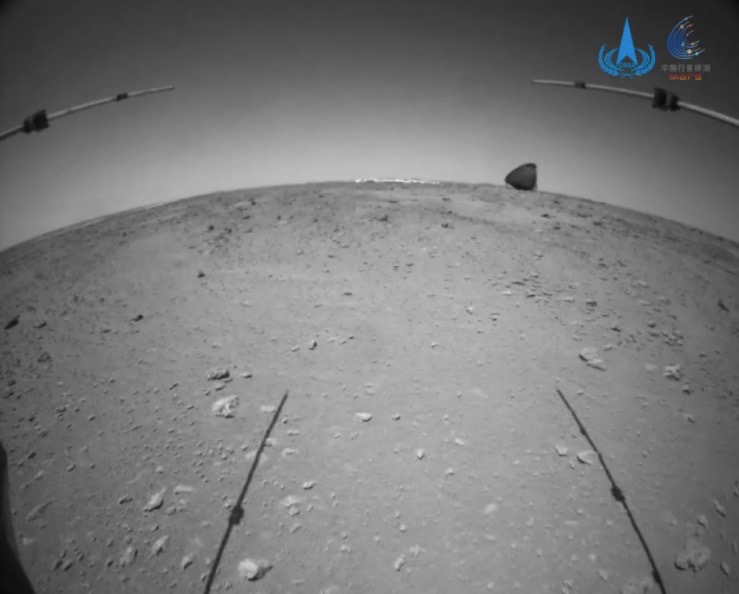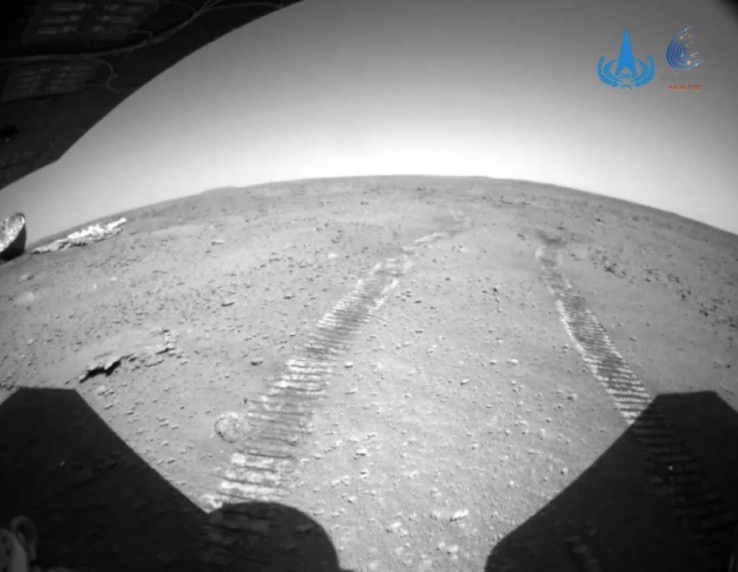China's Mars rover Zhurong has given us a nice close-up look at some of the vital gear it used to land safely on the Red Planet in May.
On Monday (July 12), Zhurong rolled up to investigate its parachute and backshell, which fell to the red dirt a short distance away from the rover's landing site on the huge Martian plain Utopia Planitia.
Zhurong captured black-and-white images of the gear with its hazard-avoidance cameras, including one shot that also features the rover's own tracks. And the robot snapped a stunning color photo of the parachute-backshell assembly as well. (The backshell covered the rover and its lander on its way to Mars, and through much of the planet's atmosphere.)
Related: China's Tianwen 1 Mars mission in photos

"The complete back cover structure after aerodynamic ablation, the attitude control engine diversion hole on the back cover is clearly identifiable," Chinese space officials wrote in a description of the image on Thursday (July 15).
When it took the color photo, Zhurong was about 100 feet (30 meters) from the back shell and roughly 1,150 feet (350 m) from its landing site, the officials added.
Zhurong is part of Tianwen 1, China's first fully homegrown Mars mission. Tianwen 1 launched in July 2020 and arrived in orbit around the Red Planet this past February, about a week before NASA's Perseverance rover made it to Mars.
Get the Space.com Newsletter
Breaking space news, the latest updates on rocket launches, skywatching events and more!

In mid-May, Zhurong separated from the Tianwen 1 orbiter and touched down on Mars, making China just the second nation, after the U.S., to successfully land a robot on the Martian surface and operate it for an appreciable length of time. (The Soviet Union's Mars 3 spacecraft landed successfully in 1971 but died about two minutes later. And the European Space Agency's Beagle 2 lander may have touched down safely in December 2003, but it never made contact with its handlers.)
Zhurong is studying the geology and topography of its surroundings and hunting for buried water ice, among other tasks, during a surface mission designed to last at least 90 Mars days, or sols (about 93 Earth days). The Tianwen 1 orbiter, which relays communications to and from Zhurong in addition to performing its own observations, will operate for at least one Mars year (687 Earth days), if all goes according to plan.

As of Thursday, Zhurong has been exploring the Martian surface for 60 sols and has traveled a total of 1,476 feet (450 m), Chinese officials wrote in the image description.
This isn't the first time that a Mars rover has inspected its own entry, descent and landing hardware. For example, NASA's Opportunity rover gave us a similar shot in December 2004, nearly a year after it touched down.
Mike Wall is the author of "Out There" (Grand Central Publishing, 2018; illustrated by Karl Tate), a book about the search for alien life. Follow him on Twitter @michaeldwall. Follow us on Twitter @Spacedotcom or Facebook.
Join our Space Forums to keep talking space on the latest missions, night sky and more! And if you have a news tip, correction or comment, let us know at: community@space.com.

Michael Wall is a Senior Space Writer with Space.com and joined the team in 2010. He primarily covers exoplanets, spaceflight and military space, but has been known to dabble in the space art beat. His book about the search for alien life, "Out There," was published on Nov. 13, 2018. Before becoming a science writer, Michael worked as a herpetologist and wildlife biologist. He has a Ph.D. in evolutionary biology from the University of Sydney, Australia, a bachelor's degree from the University of Arizona, and a graduate certificate in science writing from the University of California, Santa Cruz. To find out what his latest project is, you can follow Michael on Twitter.









